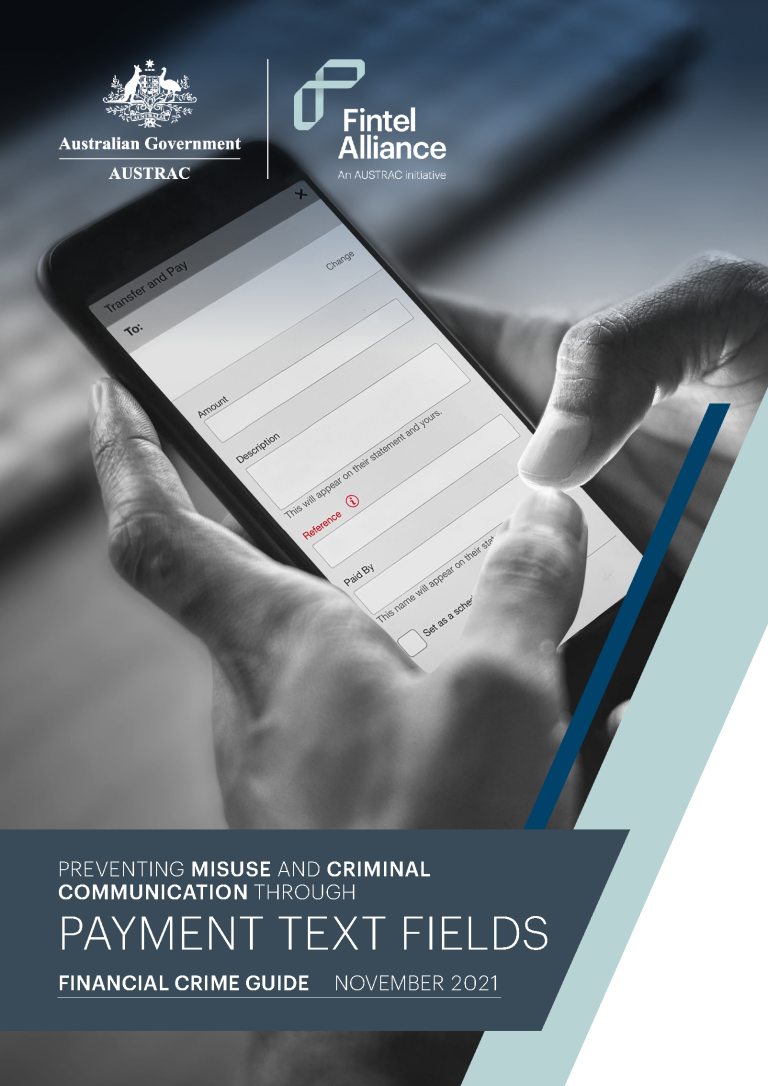Preventing misuse and criminal communication through payment text fields

Investigations into serious crime and national security matters to protect the Australian community are being supported by Fintel Alliance, a public–private partnership led by the Australian Transaction Reports and Analysis Centre (AUSTRAC).
The Alliance’s 29 partners include:
- 9 Australian Government agencies
- 7 banks
- 4 remittance and gaming industry services
- 1 university
- 8 law enforcement and security agencies in Australia, New Zealand and the United Kingdom.
The payment reference project was initiated in late 2020. It followed concerns from Fintel Alliance partners that financial transaction payment text fields were being used to harass, stalk or threaten victims.
Fintel Alliance partners recognised the harm this caused the community and began sharing trends, indicators and approaches to better understand the problem. It became evident that payment text fields were being used for a diverse range of technology-facilitated abuse including threats, extortion, circumventing protection orders and criminal communication.
Initial insights and learnings were shared through a financial crime guide which was publicly released in November 2021. The guide includes technology-facilitated abuse indicators, and led to an increase in suspicious matter reporting submitted to AUSTRAC and subsequent referrals to police for action.

Preventing misuse and criminal communication through payment text fields, November 2021
Image: AUSTRAC
To combat the misuse of payment text fields, financial institutions took these steps:
- initiated safety reporting options for customers being victimised
- blocked payments containing explicit or threatening language
- employed machine-learning models and algorithms to detect offending.
The payment reference project resulted in greater awareness of financial transactions as a communication medium vulnerable to criminal exploitation. Benefits of the project in 2022–23 included:
- offender arrests, including high-risk domestic violence perpetrators for breaches of protection orders
- police interventions to assist members of the public with mental health disorders
- an increase in the quality and quantity of suspicious matter reports submitted to AUSTRAC detailing suspected technology-facilitated abuse
- welfare checks for victims whose safety was compromised
- identification of additional crime types including child exploitation, drug trafficking and identity fraud
- financial institutions implementing controls to block or restrict abusive and offensive messaging.
As a result of the project, Australian policing agencies are now contacting community members about the harassment and abuse they have received through payment text fields and making them aware of their legal options to prevent future harassment. Police have also reported that the information within AUSTRAC referrals helped confirm breaches of domestic violence-related intervention orders. Acting on this intelligence has been crucial in the case of high-risk offenders and has very likely saved lives.
The payment reference project has significantly improved the ability of financial institutions to support vulnerable customers, through increased reporting to AUSTRAC, education and outreach.
Intelligence from financial institutions, and the methodologies outlined in the financial crime guide, contributed greatly to the enhanced monitoring of payment text fields. Initially targeting only domestic and family violence situations, this uplift in controls and analytical models has allowed banks to monitor other areas of technology-facilitated abuse and better protect their customers.
See also
Australian Government (n.d.) Fintel Alliance, AUSTRAC website, https://www.austrac.gov.au/partners/fintel-alliance, accessed 5 October 2023.
Australian Government (n.d.) Preventing misuse and criminal communication through payment text fields, AUSTRAC website, https://www.austrac.gov.au/business/how-comply-guidance-and-resources/guidance-resources/payment-text-fields, accessed 5 October 2023.



